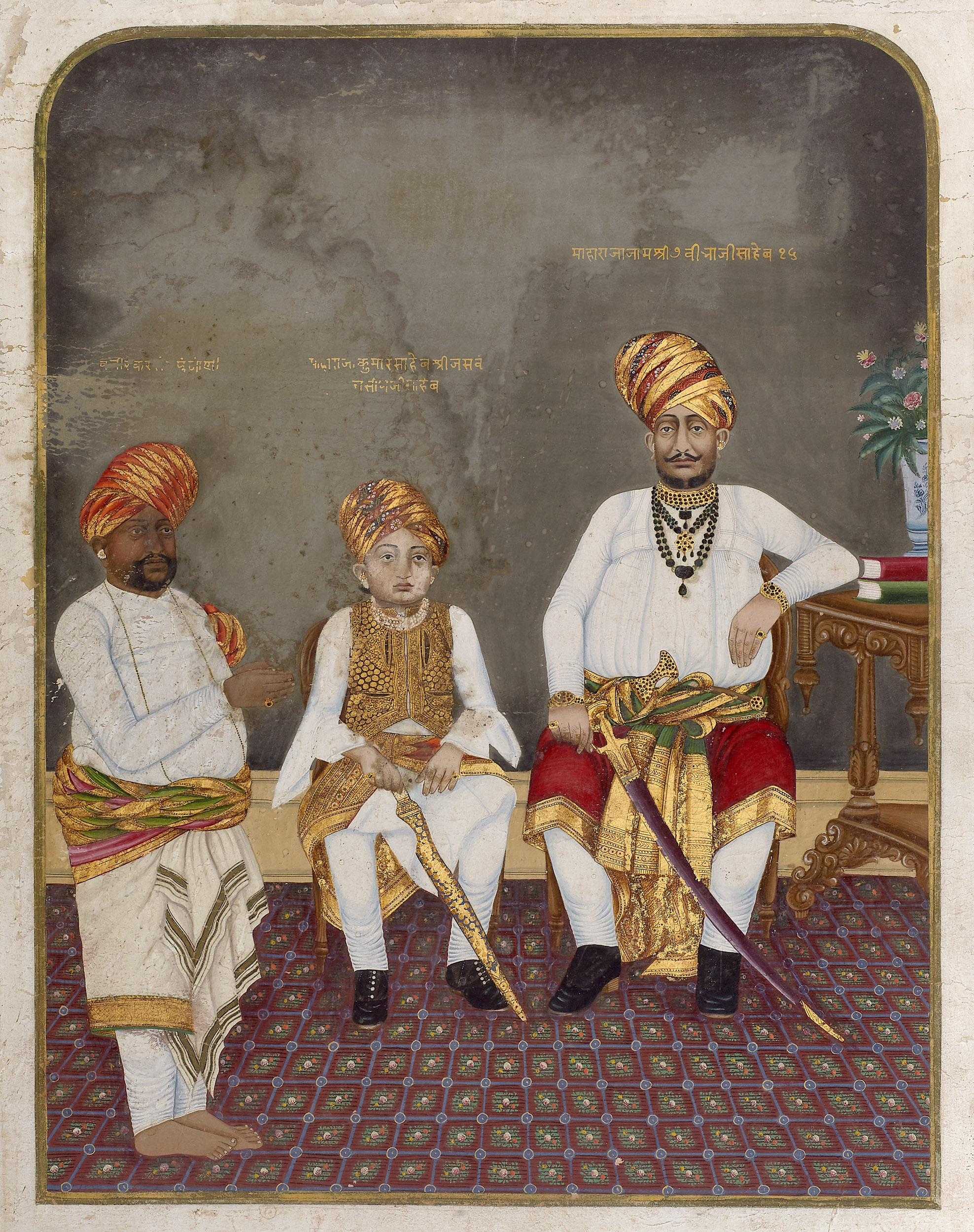Maharaja Jam Vibhaji (1827, r.1852-1895)
with His Son Kumar Jaswantji Vibhaji (1882, r.1895-1906)
Nawanagar, 1890
Opaque pigments with gold on paper
Image: 41 x 31.3 cm
Folio: 44.5 x 36 cm
Inscription: (front) L to R – ……… Puthan, Maharaj Kumarsaheb Shri Jaswantsingh ji Saheb, Maharaja Jam Shri 7 Vibhaji Saheb 16
Vibhaji was the only one of his father’s seven sons to outlive him. He would succeed his father, Ranmalji, in 1852. The relative peace of his father’s reign did not continue into his. Soon after his accession, the Waghers of Okhamandal would rise up against the Marathas of Baroda, who were unable to quell the rebellion. The Waghers, successful in their battles against the Marathas of Baroda, and the British who had come to help would soon set their sights on Jamnagar. In the battle that took place, Vibhaji and his men managed to defeat the Waghers.
It is said that Vibhaji once spotted a Sidi woman by the name of Dhanbai in the local marketplace and asked her to join his harem. She agreed on the condition that he makes her his wife and that her three sisters were allowed to join her in his harem. Very soon afterward, in 1856, a young boy by the name of Kalobha was born. His birth occurred so soon after the two were married that people began to question if Vibhaji was actually the boy’s father. Kalobha was raised as the heir until 1877 when poison was found in Vibhaji’s food and an investigation found that Kalobha was the one that was behind the attempted poisoning.
At this point, Vibhaji thought it best to adopt. So he turned to his cousin, Jhalam Singh Ji who offered Vibhaji one of his four sons. It was not long after the adoption that the boy was found dead. Many believed that Dhanbai had him poisoned. Another boy was adopted, again from Jhalam Singh Ji. This time it was his grandson Ranjit Singh Ji. Ranjit was raised away from Jamnagar to prevent him from suffering a similar fate as his uncle.
Around the same time another boy, Jaswant Ji, who is shown seated with his father in our portrait, was born to one of Dhanbai’s sisters. The sisters pleaded with Vibhaji to have the Bombay government recognize Jaswant Ji as the legitimate heir of Jamnagar. Lord Ripon, the Viceroy of India, who held Vibhaji in high regard, agreed to his demands. Jam Jaswant Singh Ji died at the age of 24, without an heir. Six months later the adopted son, Ranjit Singh, who had attended boarding school in Cambridge and become a world class cricketer, would return to India and succeed as the Maharaja of Jamnagar.
Vibhaji presented a rhinoceros hide shield, or dhal, to King Edward VII, then Prince of Wales, during his tour of India in 1875-761. In 1877, the year of the attempt on his life, Jam Vibhaji attended the Imperial Assemblage at Delhi where he received a banner from His Excellency the Viceroy and Governor General, and his salute was increased from eleven to fifteen guns. In January 1878 the Jam Sahib was made K.C.S.I, which can be seen in the following picture (cat. 51).
An equestrian portrait of Vibhaji in his youth was recently offered on the London Market2 and a portrait of Vibhaji enjoying a nautch performance by the same artist is in the Louvre Abu Dhabi3. Another portrait showing him very much as he appears in our pictures was recently exhibited in London4.
1. Royal Collection Trust, RCIN 11458.
2. Bonhams, Indian, Himalayan & Southeast Asian Art, 9/18/2013, Lot 164.
3. Losty, Indian Miniatures from the James Ivory Collection, Cat. 15.
4. Christie’s, The Collection of Paul F. Walter Online, 21 -28 September 2017, LOT 629.
